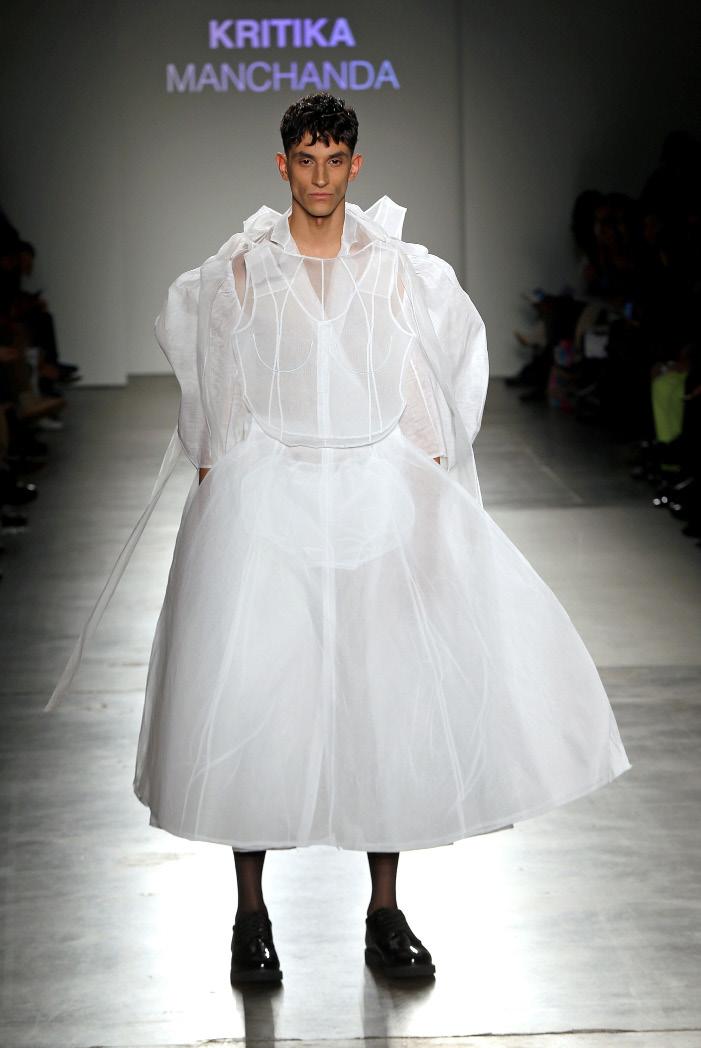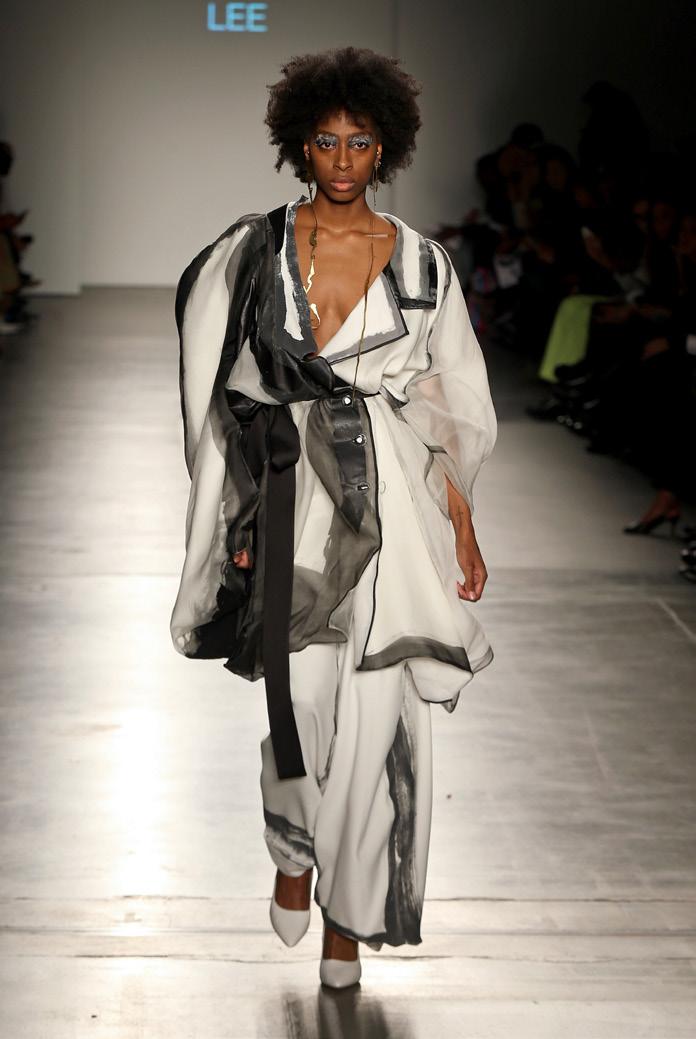
6 minute read
To the FIT Community” Discussing the First Ever MFA Graduate Show and All That’s Happened Since
from W27 March 2020
Discussing the First Ever MFA Graduate Show, and All That’s Happened Since
Advertisement
BY MASON AUMAN
On February 7, I sat myself down on the second bench back from the runway at Pier 59, harboring what could be considered a fair, but admittedly not overzealous, amount of anticipation for the impending inaugural Fashion Institute of Technology MFA show. As the show began to unfold, this anticipation was paid off with some legitimately interesting and cool looks – I began mentally recording my review right there. But, somewhere in the middle of the procession, as I began to settle into the rhythm of the affair, a disruption came lumbering toward me. What I saw was a model, strutting with the same assuredness and poise as those who preceded her, but adorned with an alarming set of accessories. Large over-pronounced ears, cartoonish oversized ruby red lips and eyebrows ranging from exaggerated to extravagantly unruly.
The collection, designed by Junkai Huang, was purportedly meant to highlight the “ugly features of the body” – according to Paper Magazine. It’s worth mentioning that this glaring aesthetic choice glided by seemingly without causing any stir within this particular crowd. I scanned the room rapidly to see if others in attendance were clocking the – at best – problematic choice confronting them, and it didn’t appear that there was even a second thought lingering in the room. The show went on, after the full collection – every look accessorized with the same overtly racist features – finished its display, and the following designers sent their figures down the runway. Things wrapped up without a hitch, and everyone went about their day. It wasn’t until a week or so later that the collective consciousness of fashion registered what was seen that morning, and what has unfolded is likely familiar to you, as an FIT student, through a flurry of statements from President Dr. Joyce F. Brown. At this point, the story has become a layered and ungainly tale, and it’s likely that by the time you’re reading this, new layers will have been added. In the pursuit of processing any of this and coming to some sort of understanding as to how it happened – we’ve first got to establish a working timeline up to this point.
To start, the show was held on the morning of February 7, at the Chelsea Piers. But any issue with what was on display wasn’t publicly taken by news outlets until about a week later. The Instagram account “@diet_prada” created significant internet buzz around the issue on February 17, citing a New York Post article about the show and referencing the first statement made by President Brown. In that statement, Brown wrote that it’s important for students to have the “freedom to craft their own personal and unique artistic perspectives as designers, to be even what some would consider to be provocative.” Additionally, an investigation into the matter was announced. But even before this investigation was launched, we had some intel from behind the scenes at the event. African American model Amy Lefevre is said to have spoken up about the accessories backstage and was told that it was “ok to be uncomfortable for only 45 seconds.” This callous response wasn’t issued in isolation. Another student, who wishes to remain anonymous, heard show producer Richard Thornn tell those who were backstage to “back down and get away.” Lefevre, through her brave protest, walked without the accessories, but the same cannot be said for the other models.
Updates on the status of the entire debacle have been even-handed and consistent from President Brown. On February 21, an email was sent to the community that notes the steps that had been taken to address the issue at that point. The first step, according to Brown, is as follows:
“First and foremost, we have commissioned an independent investigation of ourselves. Bond, Schoeneck & King, an external law firm, will immediately conduct a thorough and objective probe into the incident, including what led up to the show and what followed.”
A good start, certainly. But Brown had more information to provide, even before the aforementioned probe yielded results, that changes the narrative of the event. According to Brown:
“It also appears – based upon information available – that the styling and accessorizing used in the show were provided to him rather than chosen at his discretion. To us, this indicates that those in charge of and responsible for overseeing the show failed to recognize or anticipate the racist references and cultural insensitivities that were obvious to almost everybody else. That’s inexcusable and irresponsible – but also why we are commissioning an independent investigation.”
The intent of this message, and the messaging coming out of the school since, has been to shift the focus and burden of blame off of the shoulders of Junkai Huang, the designer. Again, it’s been highlighted that Huang is an international student, did not intend to make any statement regarding race, and didn’t seem to be aware of even the unintended implications of the designs. Additionally, the accessories – having been reportedly chosen for Huang – are the point of issue, not the clothes themselves. The more important and troubling aspect of this significant misstep is, necessarily, the sheer number of eyes that this decision had to pass by – officials with serious fashion credentials, in a position of mentorship for young designers. How is it that the only questions raised about this decision came from students, speaking up? Besides highlighting an apparent gap in the generational understanding of acceptance and inclusion in fashion, it seems to signal an alarming lack of care.
There have been consequences for this lack of care – “the Dean of the School of Graduate Studies has been placed on administrative leave while there is an investigation into the events surrounding the MFA fashion show” writes Brown. In the interim, Joanne Arbuckle has been appointed as the acting dean of the graduate school. Currently, Ms. Arbuckle is the deputy to the President for Industry partnerships and Collaborative Programs. The missing piece here is what role, precisely, the now-on-leave Dean of the School of Graduate Studies had in the whole affair, and it’s unclear to what degree we’ll get an answer to that question.
We’re left then, to learn what we can from all that we know now – though it would seem in this case that the student body isn’t the collective that most needs an exercise in learning, with outsourced accessories and the only acknowledgement of a problem pre-news breaking coming from our ranks.
It’s a shame, really, that this happened. For the most obvious and consequential reasons like a display of unthinking bigotry and because it’s taken away from all of the other designers who worked tirelessly to have their own work showcased that morning. The story is now and will continue to be about the controversy – while the other designers who earned their spot in the lineup are relegated to the background. It’s frustrating and unfair, to say the least. So, this article will not be accompanied with images that display the facial accessories in question, you can find those everywhere else. Instead, what you are seeing is images of the other collections – an array of looks communicating the talent and passion of The Fashion Institute of Technology.■


PHOTOS COURTESY STEVEN BIBB






